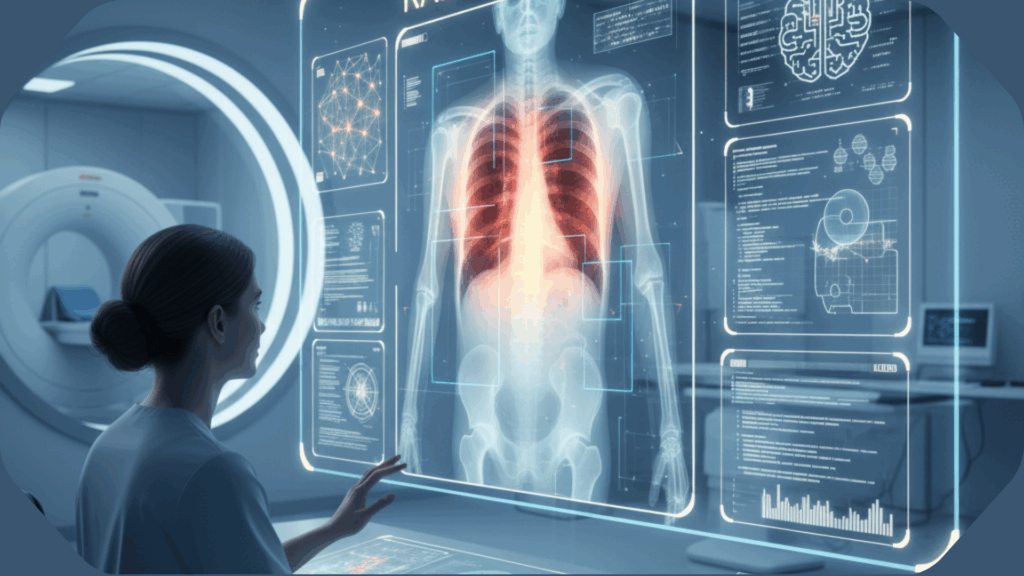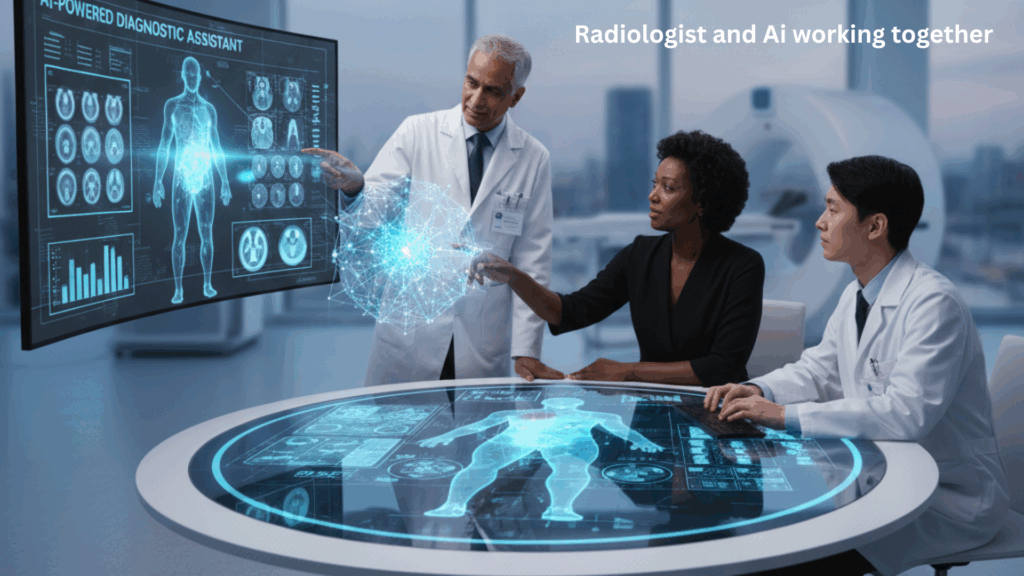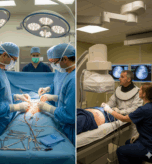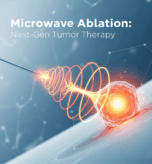Introduction

AI is changing radiology for both patients and doctors. It helps read medical images faster, gives quicker results, and supports better treatment decisions.
Imagine waiting nervously for your radiology report after an MRI or CT scan. The wait can be very stressful—every minute feels important when it comes to your health. What if technology could make the process faster and more accurate? That’s what Artificial Intelligence (AI) in radiology is doing.
The Growing Role of AI in Radiology
Radiology is very important in modern medicine. Firstly, it helps doctors find and understand many health issues, from broken bones to cancer. However, radiologists face a big problem: the number of medical scans is growing quickly. In fact, every year, the number of scans increases by more than 10% worldwide. As a result, radiologists must read scans faster while still being accurate.
AI is helping improve patient care in medical imaging. With smart technology, AI can look at thousands of scans in just minutes. It can also spot signs of problems and help radiologists make better decisions.
👉 Learn more about how advanced scanning works in our https://drvrishitsaraswat.com/our-services/
How AI with Radiology Improves Diagnostic Accuracy
One of the biggest benefits of AI is helping doctors make more accurate diagnoses in radiology. For example:
Cancer Detection: AI uses smart programs that learn from a lot of medical data. These programs can spot tiny changes in body tissues that doctors might miss. Finding these changes early helps people get treatment faster and improves their chances of getting better.
Heart Imaging: AI helps doctors look at images faster. It can find early signs of heart disease. This lets doctors give treatment before serious problems start.
Brain Disorders: Diseases like Alzheimer’s or stroke often cause small changes in the brain. These changes can be hard to see. Luckily, AI helps doctors find these early signs by showing patterns. This makes scans easier to understand and helps doctors make better diagnoses.
By lowering human mistakes and giving radiologists helpful data, patients get more accurate diagnoses.
For evidence-based insights, the Radiological Society of North America (RSNA) highlights how AI is transforming early cancer detection — read more on RSNA AI Research (external link).
Boosting Efficiency in Radiology Workflows
Radiologists spend time not just reading scans but also handling paperwork. Using artificial intelligence in their workflow can help make these tasks easier and faster.
- Automated Prioritisation: AI tools can sort urgent cases. They help doctors know who needs care first. This means patients in danger get help faster.
- Streamlined Reporting: AI makes first-draft reports, so radiologists can focus more on difficult cases instead of repeating the same tasks again and again.
- Reduced Turnaround Time: Hospitals that use AI to speed up radiology reports see great results. Sometimes, reports are ready up to 50% faster.
👉 Discover how our https://drvrishitsaraswat.com/our-services/ help hospitals improve reporting time and patient outcomes.
Enhancing Patient Outcomes Through Radiology with AI
In the end, the main goal of radiology is to help patients get better. This is where the benefits of artificial intelligence for patients really stand out.
- Early Detection, Better Survival: AI-supported screenings increase the chances of detecting diseases at early stages, improving recovery and survival rates.
- Personalised Care: AI can integrate imaging results with patient history, lab tests, and genetic data—creating a more complete clinical picture for tailored treatments.
- Minimally Invasive Planning: In interventional radiology, AI assists in planning procedures by mapping anatomy more precisely, reducing risks during surgery.
For patients, this means better results, fewer problems, and an easier experience with healthcare.
A study in The Lancet Digital Health supports this. It found that AI was able to detect breast cancer 11.5% more often than radiologists working by themselves. (Lancet AI Mammography Study).
Challenges and Considerations
Of course, every technology has its challenges. People often worry about keeping their data private. Additionally, they are concerned about how AI will fit with hospital systems. Moreover, many wonder about using AI in the right way. Radiologists say that AI should not replace doctors but should help and support them.
👉 Read our expert perspective on Ethics in Medical Imaging.

The Future: Radiologists and AI Working Together
In the end, the goal is simple: Radiologists and AI working together to give patients the best care.
First of all, it’s important to emphasise that AI won’t replace doctors.
Instead, it will support them in meaningful ways.
Specifically, AI helps by reducing stress, improving diagnostic accuracy, and, most importantly, strengthening the connection between doctors and patients.
Ultimately, this collaboration ensures better outcomes and a higher standard of care across the board. As a result, patients benefit from faster, more accurate diagnoses and improved treatment plans.
For patients, this means less waiting, more accurate diagnoses, and better treatments. Soon, as AI becomes a normal part of radiology, both doctors and patients will enjoy a healthcare system that is more reliable, faster, and caring.
Conclusion
AI in radiology is more than just new technology—it’s about saving lives. It helps create faster reports and find serious diseases earlier. By combining the skill of radiologists with the power of AI, healthcare is becoming more accurate, faster, and better for patients.
For patients, this is more than just progress—it’s hope. Hope for quicker answers, improved treatments, and healthier lives.
FAQs
Sure! Here are clear, SEO-friendly FAQ answers for your blog:
How can AI improve radiology?
AI can significantly improve radiology by quickly analysing large volumes of medical scans with high accuracy. To begin with, it helps detect abnormalities that might be missed by the human eye. Moreover, it speeds up the diagnostic process, allowing for quicker interventions. In addition, AI supports radiologists in making better-informed decisions by providing reliable data and insights. As a result, patients receive faster and more accurate care, ultimately improving overall outcomes.
How is AI used in healthcare to improve patient care?
AI is used in healthcare to look at medical data, find health problems, help diagnose illnesses, and make treatment plans that fit each patient. It can go through a lot of information very quickly. This helps doctors find diseases early, keep track of how patients are doing, and give better care.
Can AI diagnose diseases better than doctors?
AI can help doctors find diseases by spotting patterns in data that people might miss. However, AI is not meant to take the place of doctors. Instead, it is a helpful tool that works with doctors to improve how fast and accurately they can make a diagnosis. When doctors use AI along with their own knowledge, they can give better care to patients.
How can doctors best integrate AI into medical care?
Doctors can get the most out of AI by using it as a helpful tool, not a replacement. This means learning how AI systems work, understanding the information they provide, and combining that with their own medical knowledge. By doing this, doctors can make better decisions that focus on the needs of each patient. Working together, AI and doctors can improve the quality of care.
Is ChatGPT better than a doctor?
No, ChatGPT is an AI language tool that can give information and answer questions. But it cannot replace the care, experience, or judgment of a trained doctor. It’s best to use ChatGPT as a helpful resource, not as a replacement for medical advice.






